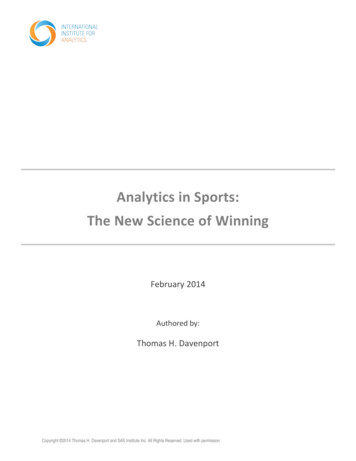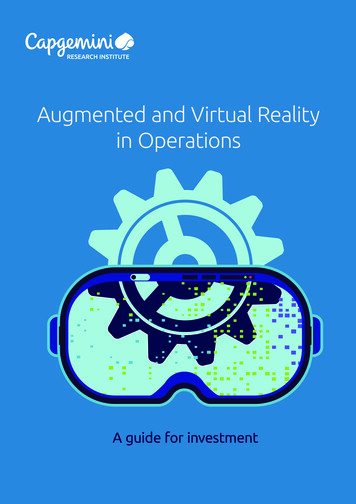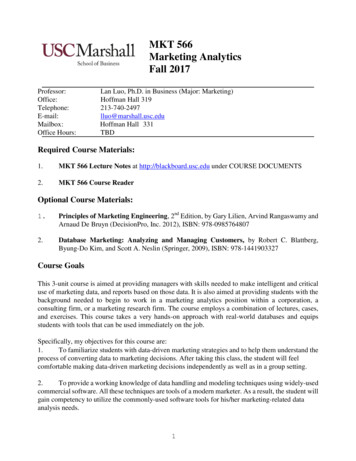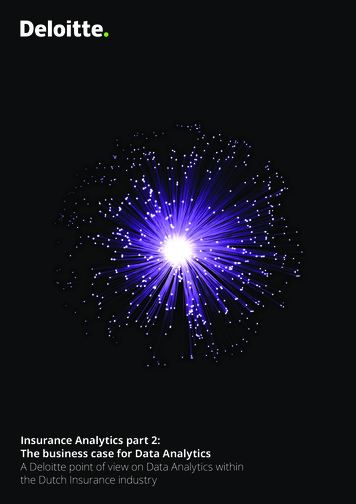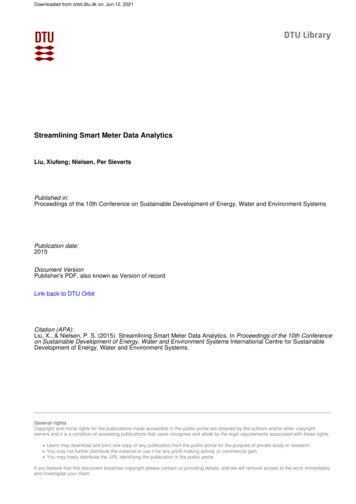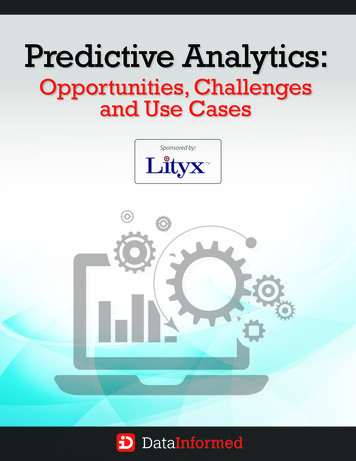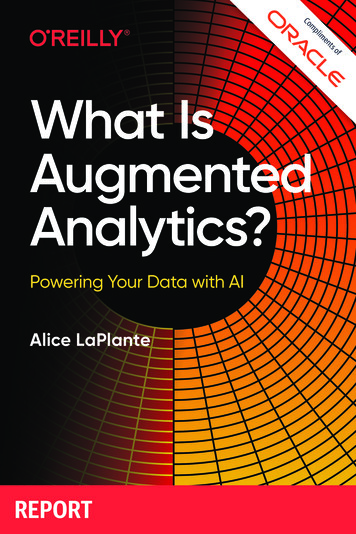
Transcription
ComplimentsofWhat IsAugmentedAnalytics?Powering Your Data with AIAlice LaPlanteREPORT
AugmentedAnaly csEmpower Businesswith AI andData-DrivenInsightsLearn Moreoracle.com/analy cs
What Is AugmentedAnalytics?Powering Your Data with AIAlice LaPlanteBeijingBoston Farnham SebastopolTokyo
What Is Augmented Analytics?by Alice LaPlanteCopyright 2019 O’Reilly Media, Inc. All rights reserved.Printed in the United States of America.Published by O’Reilly Media, Inc., 1005 Gravenstein Highway North, Sebastopol, CA95472.O’Reilly books may be purchased for educational, business, or sales promotional use.Online editions are also available for most titles (http://oreilly.com). For more infor‐mation, contact our corporate/institutional sales department: 800-998-9938 or cor‐porate@oreilly.com.Acquisitions Editor: Jonathan HassellDevelopment Editor: Melissa PotterProduction Editor: Deborah BakerCopyeditor: Octal Publishing, LLCJuly 2019:Proofreader: Charles RoumeliotisInterior Designer: David FutatoCover Designer: Karen MontgomeryIllustrator: Rebecca DemarestFirst EditionRevision History for the First Edition2019-07-02: First ReleaseThe O’Reilly logo is a registered trademark of O’Reilly Media, Inc. What Is Augmen‐ted Analytics?, the cover image, and related trade dress are trademarks of O’ReillyMedia, Inc.The views expressed in this work are those of the author, and do not represent thepublisher’s views. While the publisher and the author have used good faith efforts toensure that the information and instructions contained in this work are accurate, thepublisher and the author disclaim all responsibility for errors or omissions, includ‐ing without limitation responsibility for damages resulting from the use of or reli‐ance on this work. Use of the information and instructions contained in this work isat your own risk. If any code samples or other technology this work contains ordescribes is subject to open source licenses or the intellectual property rights of oth‐ers, it is your responsibility to ensure that your use thereof complies with such licen‐ses and/or rights.This work is part of a collaboration between O’Reilly and Oracle. See our statementof editorial independence.978-1-492-05842-7[LSI]
Table of ContentsWhat Is Augmented Analytics?. . . . . . . . . . . . . . . . . . . . . . . . . . . . . . . . . . . 1Executive SummaryA Growing MarketAugmented Analytics: A PrimerBenefits and Roadblocks of Augmented AnalyticsWho Is Using Augmented Analytics?Best Practices for Augmented AnalyticsReal-World Uses of Augmented AnalyticsRiverbedConclusion133111314172229iii
What Is Augmented Analytics?Executive SummaryBusinesses are collecting ever-larger volumes of data—structuredand unstructured alike. IDC predicts that the “global datasphere”will grow from 33 zettabytes (ZB) in 2018 to 175 ZB by 2025. Thisnumber is staggering. Note that one zettabyte is approximately equalto one billion terabytes. If each terabyte were a kilometer, a zettabytewould be equivalent to 1,300 round trips to the moon. Now multiplythat by 175 and you begin to get the picture of the data delugetoday’s businesses face.Businesses that figure out how to make decisions using all this data—those that are “data driven”—will come out ahead. By making bet‐ter use of their rich information resources to make better decisions,they will perform better than those that operate on gut feel or anec‐dotal evidence. Forrester found that data-driven companies groweight times faster than those that work from intuition. Indeed, such“insights-driven” businesses grow, on average, an impressive 30%annually and are forecast to earn 1.8 trillion more than their lessadvanced peers by 2021, as illustrated in Figure 1-1.But traditional analytics solutions will take businesses only so farwhen attempting to make use of data.1
Figure 1-1. Insights-driven businesses have a distinct advantageAugmented analytics is the latest way to think about data and ana‐lytics. It includes embedding artificial intelligence (AI), often in theform of machine learning and natural language processing (NLP),into traditional analytics. It is vastly different from traditional ana‐lytics or business intelligence (BI) tools because these AI technolo‐gies are always working in the background to continuously learnand enhance results. In particular, augmented analytics allows fasteraccess to insights derived from massive amounts of structured andunstructured data; this intelligence helps uncover hidden insights,remove human bias, and predict bias.By deploying augmented analytics, not only can organizationsdemocratize use of the data—that is, make it easy for business usersand executives to make decisions based on data without help fromdata scientists or IT professionals—but they can go beyond predic‐tions of future business events or scenarios and access unbiased pre‐scriptive advice on what to do next.In this report, we precisely define what augmented analytics is. Weexplain how analytics that are driven by machine learning and AIaccelerates time to insights from all of your data, and brings intelli‐gence to help uncover hidden insights, remove human bias, predictresults, and even prescribe solutions. We explain best practices fordeploying augmented analytics, and show how you can use augmen‐ted analytics practically within real-world case studies.2 What Is Augmented Analytics?
A Growing MarketAugmented analytics is a high-growth force in business today. Ana‐lyst firm Research and Markets predicts that the global augmentedanalytics market will grow from 4.8 billion in 2018 to 18.4 billionby 2023, at a compound annual growth rate (CAGR) of a veryimpressive 30.6% at a time when the enterprise software market isexpected to grow at only an 8% CAGR. Growth of augmented ana‐lytics will be highest in the banking, financial services, and insur‐ance markets.According to a recent survey, embedding machine learning in ana‐lytics is a top 10 concern of BI and analytics stakeholders, includingusers, vendors, and analysts, as shown in Figure 1-2.Figure 1-2. Importance of augmented analyticsThe McKinsey Global Institute performed an analysis of the valuecreated by embedding machine learning in analytics across 400enterprise use cases and found that the technologies have the poten‐tial to create as much as an additional 15.4 trillion in value by 2020.But what exactly is augmented analytics? Let’s examine that beforewe move on.Augmented Analytics: A PrimerAugmented analytics is the marrying of two technologies: analyticsand AI. We discuss these separately, and then explain what happenswhen you bring them together in a single solution or platform thatpossesses contextual awareness.A Growing Market 3
AnalyticsAnalytics is the process of identifying patterns in data. It uses statis‐tics, operations research, and other mathematical tools to makesense of information generated or collected by organizations. It isespecially helpful as data volumes grow, when manual calculationsare too difficult or complex.In this era of big data, analytics has become essential to doing every‐thing from understanding sales trends to segmenting customersbased on their online behaviors to predicting how much inventoryto hold. Yes, the data itself is a tremendous asset, but analytics iswhat makes data deliver value. And not just to business, but tosports, medicine, engineering, or any activity in which largeamounts of data are involved.AIAI is the computer science practice of building automated systemsthat are able to perform tasks that normally require human intelli‐gence. AI encompasses a broad range of technologies, such as com‐puter vision, NLP, and neural networks.Machine learning is one of the technologies that falls under theumbrella of AI. It makes it possible for systems to learn from pro‐cessing data. In other words, computer systems don’t need to bespecifically programmed by humans to anticipate every scenario—they automatically learn and improve from what the data tells them,and from their experience with that data, to make better predictionsor decisions.IDC predicts that enterprise spending on AI solutions will top 77.6billion in 2022, more than three times the 24.0 billion in 2018, asillustrated in Figure 1-3. This represents an “impressive” 37.3%CAGR between 2017 and 2022, according to IDC.The top reason that marketers are adopting machine learning andanalytics is to improve the customer experience. A full 82% of enter‐prises already use machine learning to personally target customers,and 64% use it to deliver targeted content and promotions to them.4 What Is Augmented Analytics?
Figure 1-3. Spending on AI solutions is accelerating.All of this is paying off. McKinsey discovered that 82% of businessesthat adopted machine learning received, on average, a 17% returnon investment (ROI). Companies in the technology, media andentertainment, and telecommunications fields are achieving thehighest ROI.Data scientists write the mathematical models underlying machinelearning systems. Machine learning modeling requires significantskill, education, and training, and the data professionals capable ofdoing this are scarce. According to LinkedIn, demand for data sci‐entists is “off the charts,” with a shortage of more than 150,000 datascientists in the US alone. Happily, many AI and machine learningmodels in the public domain can be found on community websitesfor free; businesses can use these models to get started with AI andmachine learning.Bringing It All TogetherWhen you embed machine learning and AI into analytics, you getaugmented analytics. Augmented analytics is a technology that auto‐mates the selection and preparation of data, the generation ofinsights, and the communication of those insights. The main thingthat is new in this space is the democratization of advanced analyticstools. Today, advanced analytics is available to a broad range of busi‐ness users: executives, managers, line-of-business workers, and citi‐zen data scientists—those employees who have a natural aptitudeand excitement for data science without the formal training.Augmented analytics solutions come prebuilt with models and algo‐rithms so that companies don’t need a data scientist to do this work.And these models are hidden under much friendlier interfaces sothat users without data science training or PhDs in statistics can useAugmented Analytics: A Primer 5
the tools. Indeed, this is one of the key differences between augmen‐ted analytics and traditional analytics. With augmented analytics,the AI and machine learning are built into the product. The verycomplex model-building and number-crunching is still happening—but it’s always on, always working in the background to continu‐ously learn and help users make more accurate decisions.Because leading augmented analytics platforms feature NLP, thisallows nontechnical users to easily ask questions from source data;natural language generation (NLG) then automates the process oftranslating complex data into text with intelligent recommendations,thereby accelerating analytic insights.By using automated recommendations for data enrichment and vis‐ualization, anyone can quickly uncover unseen patterns and predicttrends to optimize the time it takes to go from data to insights todecisions.The Business Application Research Center (BARC) 2018 BusinessIntelligence Survey found that augmented analytics will completelytransform the user experience, making the shortage of data scientistsless urgent for many businesses.NLP technology also helps drive the ability for nonexpert users tomake sense of large amounts of data. Users can ask questions of thedata using standard business terminology, and the software will findand query the right data and make the results easy to digest usingvisualization tools or natural language output.Augmented analytics can help every data-hungry user of analytics—from business analysts to IT professionals, to the C-suite—in thefollowing ways:Recommend, prepare, and enrich dataRather than having to decide which datasets to query, as withtraditional analytics, an augmented analytics solution will rec‐ommend which datasets to include in analyses, alert users whenthose datasets are updated, and suggest new datasets if users arenot getting the results they expect.Create instant charts and graphicsThis helps interpret and communicate results in an easilyunderstandable context to help make swift business decisions.6 What Is Augmented Analytics?
Natural language interfacesThis allows users to do querying in natural language, to activatespeech-to-text capabilities, and to get results generated—andeven spoken—using everyday business language.Forecast trending and clustering of dataIt takes just one click to get accurate forecasts and predictionsbased on historical data.Use proactive, personalized analytics with mobile applicationsAugmented analytics provides a personalized assistant thatunderstands individual users—such as using their location todetermine what charts to present to a client at an offsite salesmeeting.Augmented analytics will also be personalized and proactive to theextent that it will present insights based on patterns it detects inusers’ questions. Through self-learning, it will even anticipate futurequestions that perhaps a user hasn’t yet thought of.Oracle’s Data Analytics Maturity ModelOracle has defined the analytics maturity model as consisting ofthree waves: centralized, self-service, and augmented, as illustratedin Figure 1-4.Figure 1-4. The Oracle analytics model (source: Oracle, May 2019)If you centralize your analytics efforts, you get centralized data andsemantic information for consistent metric definitions. This resultsAugmented Analytics: A Primer 7
in stronger governance than if your data is scattered throughoutmultiple repositories or datacenters.If you build a self-service model for analytics so that users don’tneed to involve a data “gatekeeper” to get access to the data theyneed, you will boost user productivity dramatically, speeding upbusiness decisions. You will also be able to use nonstandard datasetsfrom external or personal sources, such as suppliers, customers, andexternal data feeds such as commodity prices or weather data.Finally, if you apply automation, machine learning, and AI withinyour analytics process, you will realize faster time to insights fromyour data, which means faster time to decisions and the ability tobecome a true data-driven business.It’s important to understand that this is not a linear model. You donot need to centralize your augmented analytics initiative before youimplement self-service, or achieve self-service before going augmen‐ted.Leading modern analytics platforms will offer all three of theseoptions at one time.There are four ways to use analytics:DescriptiveThis type of analytics simply looks backward at historical infor‐mation and describes what happened. You can query the data todiscover, for example, the retail sales volume last quarter or howhigh employee turnover was last year. Much descriptive analyt‐ics work is done by humans using Excel spreadsheets.DiagnosticNow that you know what happened, you want to know why. Youuse analytics to find out that the reason overall revenuesdeclined was that sales of women’s shoes dropped precipitously,or that the reason for heightened employee churn was that anew manager was hired in the finance department. In this stage,much of the work is still human centered and not yet automa‐ted.PredictiveAnalytics can also be applied to data to make predictions aboutwhat will happen next. Based on historical trends—and, impor‐tantly, assumptions about the future—what will overall revenues8 What Is Augmented Analytics?
look like next quarter? The machine does more, and the humanless, of the work in this stage.PrescriptiveFinally, some recommendations. What should we do to ensurethat sales continue on an upward trajectory?Eliminating Bias from the EquationThe human-versus-machine control aspect of analytics maturity isimportant. Earlier in the analytics maturity model, analytics toolsare controlled by humans—and tend to have human biases. Forexample, users who seek answers from data will make assumptions.They will choose what data to query, and they will structure queriesbased on their understanding and preconceived notions about thetopic. Because of this, traditional analytics arguably introduces biasinto the results.This is where augmented analytics can shine. The data determineseverything—not users’ assumptions. For example, traditionally ifyou want to forecast sales for the next quarter, you would make vari‐ous assumptions, project it out, and build a model based on your socalled expert judgment. You might estimate what the sales growthrate would be based on economic indicators from Wall Street, forinstance. Alternatively, economists could be predicting a downturn,and you might project less ambitious sales numbers.On the other hand, with augmented analytics, the data itself deter‐mines all of these things. The machine learning model parses data toidentify which datasets to access in response to a query about futurerevenues. The model also rephrases the natural language query fromthe human into machine language that is impartial. The predictionsthen typically are more accurate and, in many cases, much faster.Also, augmented analytics can actually inform users about otherdatasets that might be useful in completing a particular analysis.Augmented Analytics in the CloudAlthough businesses can certainly deploy augmented analytics on anon-premises infrastructure, many, if not most, organizations choosea cloud-based infrastructure. The prime reasons are elastic scalabil‐ity and cost effectiveness. AI technologies such as machine learningand NLP are very compute-intensive—they require lots of CPUs, orAugmented Analytics: A Primer 9
even very costly graphics processing units (GPUs)—but they are notnecessarily predictable in when they demand those resources. Manybusinesses will thus experience tremendous peaks and troughs inprocessing, and the differences between the highs and lows can bemassive. Businesses that stick with an on-premises infrastructuremust plan for those peaks by provisioning sufficient compute, stor‐age, and network resources, and plan for future growth by purchas‐ing all of the resources upfront. This incurs high capital as well asoperational costs because of course after those resources have beenprovisioned and deployed, they must also be managed and main‐tained. This is not only costly, it is slow given that provisioning newservers can take months in some organizations. And then many ofthose resources might be left unused much of the time.Also, because the cloud can handle much larger amounts of data,you never need to aggregate or truncate data so that it fits on youron-premises infrastructure. Optimizing machine learning requiresthat all data be used to produce the most accurate predictions. Datashould also be used in its lowest granularity to prevent the introduc‐tion of false insights based on preaggregations. Indeed, aggregatingor truncating data can defeat the very business agility that analyticsis supposed to achieve.It’s not surprising then, that according to a recent Deloitte study,only 15% of companies say they prefer on-premises platforms whendeploying AI. (Keep in mind that this 15% of companies includesfirms in industries, like finance and gaming, which are required bylaw to remain on-premises.) The popularity of cloud-based AI plat‐forms is further confirmed by their annual global growth rate, whichDeloitte estimates to be a “remarkable” 48.2%.In the cloud, businesses can dynamically provision whatever resour‐ces they need and scale up and down as required. This pay-only-forwhat-you-need model is not only cost-effective, but it also makesbusinesses extremely agile in that new compute and storage can beprovisioned in minutes, not weeks or months.Indeed, the cloud is essential for delivering many of the benefits ofaugmented analytics, as we explain in the next section.10 What Is Augmented Analytics?
Benefits and Roadblocks of AugmentedAnalyticsMany benefits accrue to businesses that move up the maturity curvefrom traditional analytics to augmented analytics. But there are acouple of potential roadblocks you should be aware of. We coverboth in this section.Benefits of Augmented AnalyticsHere are four of the chief benefits that businesses are deriving fromaugmented analytics.Make faster decisionsBusiness agility is on everyone’s mind these days. The ability to reactswiftly and decisively in response to changes in volatile markets isessential. Today, with new competitors arising from unlikely places,businesses can’t wait weeks or even days to get the informationrequired for both strategic and tactical decision making. With aug‐mented analytics, getting complete, easy-to-decipher reports inresponse to even highly sophisticated ad hoc queries into the handsof those who need them can be achieved much more rapidly thanwith traditional analytics solutions.Make better decisionsIt’s not just speed that matters. In the past, executives would makesnap decisions based on limited information and gut feel only—often with disastrous results. With augmented analytics, your deci‐sions can be based on facts and hard numbers. Additionally, becauseof AI and machine learning, all available data—structured andunstructured—can be processed. Using all available data versus justsubsets of data ensures that you get better insights from the resultinganalyses, and thus make better, more confident, and more trustwor‐thy decisions.Democratize data use throughout your organizationThere has been talk for decades about the democratization of data—making data available to every employee who needs it—and ofempowering citizen data scientists. Augmented analytics finallymakes this possible. AI in the form of complex machine learningBenefits and Roadblocks of Augmented Analytics 11
algorithms and NLP is all there, under the covers, putting insight atthe fingertips of anyone who needs it. In the future, AI will be every‐where analytics is, and will become second nature to everyone.Leading augmented analytics solutions come with out-of-the-boxembedded machine learning and AI models in them, so users canget started immediately on analyses with very little training.Although data scientists are still required to adjust these models orto build additional ones, the productivity of regular business usersand nondata specialist users soars immediately upon deployingthese solutions.Become a true data-driven companyMost organizations today strive to be data driven—or to follow whatthe data tells them. The documented financial payoff is certainlyworth it. By deploying augmented analytics, users of all typesthroughout your organization get the deep insights they need fromthe data to make better decisions without requiring hand-holdingfrom data professionals or IT.Roadblocks to Using Augmented AnalyticsTo take advantage of the many benefits we just outlined, businessesmust overcome some obstacles to take advantage of augmented ana‐lytics throughout their operations. These barriers fall into two cate‐gories: technical and cultural.Technical impedimentsThe biggest issue, particularly for larger or more established compa‐nies, is the so-called technical debt—the existing large investment inlegacy technologies that they can’t simply abandon in rip-andreplace scenarios. This includes legacy infrastructure, too. How doyou cost-effectively move to the cloud for augmented analytics whenyou’ve already put substantial investment into traditional onpremises databases and analytics tools? This is not something thatcan be done overnight.That’s why newer companies, or companies “born in the cloud,” willhave a much easier time moving swiftly into the augmented analyt‐ics world.12 What Is Augmented Analytics?
Cultural impedimentsIn addition to technical roadblocks, there are the cultural andorganizational issues to consider. It’s not easy to move from a tradi‐tional analytics model, in which IT acts as gatekeeper to the preciouscompany datasets, to a self-service model in which anyone canquery the data to get an answer to pressing business questions.Although attitudes have improved as data becomes more generallyavailable, there’s still the ingrained belief that knowledge is power.People might want to hold onto the advantage they feel they get byknowing things others don’t. Training is probably necessary to helpemployees overcome this barrier.Perhaps most important, decisions should no longer be made by theHIPPO (the highest-paid person in the office) but by listening towhat the data tells you. This can be an immense cultural shift—ask‐ing people to come to meetings armed with data, not opinions.Although a fairly recent technological development, augmentedanalytics is already being used by Fortune 1000 companies through‐out various industries—including manufacturing, finance, life scien‐ces, ecommerce, energy, internet, and health care. We discuss whouses augmented analytics in the next section.Who Is Using Augmented Analytics?Augmented analytics is being used today to get accurate, unbiased,and actionable insights across a broad range of business functions.Here are some of the ways it is being used:SalesSalespeople don’t need to know what datasets might have theinformation they are looking for, and they don’t need to learndifficult statistical terms or interfaces. They can say “show mesales for this region,” and the NLP technology interprets thatspeech into language the system can understand. The machinelearning finds the relevant data and even determines the bestcharts to show to visualize the data in context. Salespeople canuse this in the field on their mobile devices, and intelligent loca‐tor technology such as GPS will let the system know what geo‐graphical data is relevant. A sales professional might want to doa more complex analysis, and ask “Why are sales down in oureastern territory?” The machine learning system will perform aWho Is Using Augmented Analytics? 13
root cause analysis and display the answer in easily understand‐able words and graphics.MarketingMarketing professionals today want quantitative results for howwell their campaigns are doing on a very granular level—andthen they want to drill down to see why a particular campaignmight be doing better in one region or among one customersegment than another. Augmented analytics can do this and alsoinform marketers about the existence of additional data abouttarget audiences that they weren’t aware of that will make cam‐paign targeting much more effective.FinanceWith traditional analytics, financial predictions involve makinga significant number of assumptions: estimated economicgrowth, expected interest rates, or other external forces overwhich finance professionals might have opinions but not facts.With augmented analytics, the machine learning bases its pre‐dictions on the data only, leaving individual judgment and bia‐ses out of it, so organizations get more accurate predictionsabout revenues and profitability.Human Resources (HR)With traditional analytics, it’s common for HR professionals toask questions like “Why is attrition up?” only to get historicalcharts of the last three or six months of employee turnover.They need to dig in further—typically involving IT or data spe‐cialists—to try to understand why. Augmented analytics makesthe answer to this question actionable. For example, an analysisof the data could show that turnover is highest around the timeof employee annual reviews, signaling something is wrong withthat process, upon which HR can take immediate action.To get results like this, companies need to follow some best practicesthat pioneers and experts in augmented analytics have identified.Best Practices for Augmented AnalyticsAlthough the rewards are considerable, moving up the data analyt‐ics maturity curve takes time—and care. Here are some best practi‐ces for successfully deploying augmented analytics.14 What Is Augmented Analytics?
Mandate Data-Driven Decision Making from the TopDownSenior management must get behind it. No longer can businessdepartments or groups make decisions based on what the HIPPOdemands. No one should come to a meeting unless prepared topresent data that supports their position. Incentives should be struc‐tured to reward those who make data-driven decisions.Empower and Trust Users Throughout Functional Areasand Organizational LevelsMoving to augmented analytics requires moving to a self-servicedata model, which in turn requires trust. This requires building an“enlightened” organizational culture in which leaders—business andtechnical—release control to users so that they can access and usedata to make decisions as appropriate to their roles and responsibili‐ties.Balance Self-Service with Centralized GovernanceMost organizations with low analytics maturity do not have formaldata governance programs in place. They might have thought aboutit, and they might understand the importance of it, but they simplydon’t know where to start. Small companies, especially, strugglebecause of the cost barrier of entering into the realm of data central‐ization and imposing proper governance on analytics initiatives.Data governance is simply the rules by which data is managed. Thisincludes acquiring, storing, moving, transforming, analyzing,reporting, and deleting it. It is the framework by which data isensured to follow both internal and external guidelines for securityand privacy. This means that organizations must understand howdata is collected, how it is used, how it moves through the organiza‐tion, how it’s changed, and how it’s stored. They also need to ensurethat access to data is given on the principle of permissions: there’s noreason why a finance professional should have access to H
data using standard business terminology, and the software will find and query the right data and make the results easy to digest using visualization tools or natural language output. Augmented analytics can help every data-hungry user of analytics— from business analysts t


